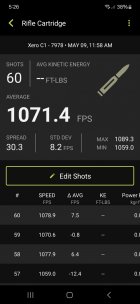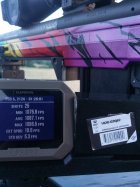How did it do down range? I could care less about ES or any of those other numbers. All that matters is how it does on the targetHere is my personal new best that I've shot with a 1 in 12 twist shilen
You are using an out of date browser. It may not display this or other websites correctly.
You should upgrade or use an alternative browser.
You should upgrade or use an alternative browser.
Best ES with most shots, what's good enough
- Thread starter S&sprecisionTx
- Start date
CharlieNC
Gold $$ Contributor
The physics of ballistics dictate a faster bullet will impact higher. But we do not know where the fast vs slow exits on the harmonic curve, ie degree of positive compensation to minimize target poi differences. Lower SD issues better, but no universal cutoff value is possible.
Wind and shooter influence aside, the physics of ballistics with .22LR dictates trajectory -- such as a faster bullet having a higher impact -- only when the bullet itself is perfectly formed. When it's not, the trajectory is less predictable. One result is that MV and POI may not match.
Soft lead projectiles such as .22LR bullets and airgun pellets are very difficult to manufacture to nearly perfect form. Some bullets will be less perfect than others. Here form includes such characteristics such as center of gravity as well as bullet shape and dimensions, especially the all important bullet heel. When these are less than perfect, trajectories can't be perfectly predicted.
Soft lead projectiles such as .22LR bullets and airgun pellets are very difficult to manufacture to nearly perfect form. Some bullets will be less perfect than others. Here form includes such characteristics such as center of gravity as well as bullet shape and dimensions, especially the all important bullet heel. When these are less than perfect, trajectories can't be perfectly predicted.
Hi-NV Shooter
Gold $$ Contributor
Logically with all barrels when at a static state would have some droop (pointing down) so looking at PC a faster bullet will exit earlier than slower one therefore wouldn't POI be higher for a slower bullet since the barrel will have time to obtain maximum upward movement.The physics of ballistics dictate a faster bullet will impact higher. But we do not know where the fast vs slow exits on the harmonic curve, ie degree of positive compensation to minimize target poi differences. Lower SD issues better, but no universal cutoff value is possible.
and because earlier exit with the faster bullet would be lower in the barrel's upward movement. POI will be lower. with PC trying to find that window where both intersect and exit timing is the same for both fast and slow bullets will give same POI. I never seen it yet, I don't think it is possible.
Lee
CharlieNC
Gold $$ Contributor
Logically with all barrels when at a static state would have some droop (pointing down) so looking at PC a faster bullet will exit earlier than slower one therefore wouldn't POI be higher for a slower bullet since the barrel will have time to obtain maximum upward movement.
and because earlier exit with the faster bullet would be lower in the barrel's upward movement. POI will be lower. with PC trying to find that window where both intersect and exit timing is the same for both fast and slow bullets will give same POI. I never seen it yet, I don't think it is possible.
Lee
The vibration frequency is fast enough (10-20khz) but the lack of knowledge required to engineer the amplitude tor exact compensation is lacking. So for center-fire a charge weight ladder can yield a "flattish" poi node, much less sensitive but not perfect. Or the weight of a tuner to help. All better than being on the down swing of the cycle which would magnify the effect of velocity differences on the target.
Same barrel, same MV, different POI. It's not barrel harmonics.
Wind and shooter influence aside, when two or more rounds of the same lot of match ammo are shot through the same barrel and have the same MV but have different POI in the vertical plane, that difference wouldn't seem to be related to barrel harmonics.
Something else must be different. What's left? The bullet.
Wind and shooter influence aside, when two or more rounds of the same lot of match ammo are shot through the same barrel and have the same MV but have different POI in the vertical plane, that difference wouldn't seem to be related to barrel harmonics.
Something else must be different. What's left? The bullet.
Hi-NV Shooter
Gold $$ Contributor
CF is a whole different animal since you can alter the load and refine it to come close to what you need before fine adjusting with a tuner. this is often injected into rimfire discussions. IMO it is useless in the discussion pertaining to RF. until someone uses factory loaded CF ammo and tunes a rifle to be competitive on the same level as RF rifles are in BR there is no comparison.The vibration frequency is fast enough (10-20khz) but the lack of knowledge required to engineer the amplitude tor exact compensation is lacking. So for center-fire a charge weight ladder can yield a "flattish" poi node, much less sensitive but not perfect. Or the weight of a tuner to help. All better than being on the down swing of the cycle which would magnify the effect of velocity differences on the target.
In RF since we cannot adjust loads, and some will say using different lots is the same which anyone who shoots RF knows it is not the same as reloading CF. at best you can match AOL to the barrel/chamber in RF. and even this is limited as RF ammo also has variances in bullet diameter. again, reloading CF this can be vetted out of the equation.
so, with RF it is about exit timing using the tuner. adjusting the tuner to compensate for the ammo's velocity differences to get as near perfect exit timing for both slow and fast the basis of PC
Lee
CharlieNC
Gold $$ Contributor
We all know CF is different, the point is it is useful as a tool to understand harmonics. A barrel doesn't know if RF vs CF was the source of ignition. Or you can choose to ignore the CF understanding for RF applications.CF is a whole different animal since you can alter the load and refine it to come close to what you need before fine adjusting with a tuner. this is often injected into rimfire discussions. IMO it is useless in the discussion pertaining to RF. until someone uses factory loaded CF ammo and tunes a rifle to be competitive on the same level as RF rifles are in BR there is no comparison.
In RF since we cannot adjust loads, and some will say using different lots is the same which anyone who shoots RF knows it is not the same as reloading CF. at best you can match AOL to the barrel/chamber in RF. and even this is limited as RF ammo also has variances in bullet diameter. again, reloading CF this can be vetted out of the equation.
so, with RF it is about exit timing using the tuner. adjusting the tuner to compensate for the ammo's velocity differences to get as near perfect exit timing for both slow and fast the basis of PC
Lee
S&sprecisionTx
Silver $$ Contributor
This was a good lot. We had 2 cases of this lot.Had to go out and check my zero on my 1_14 shilen
Todd
TRSR8
Silver $$ Contributor
Not for nothing but you’re preaching to a guy about RF ballistics that could give you lessons.We all know CF is different, the point is it is useful as a tool to understand harmonics. A barrel doesn't know if RF vs CF was the source of ignition. Or you can choose to ignore the CF understanding for RF applications.
Similar threads
- Replies
- 5
- Views
- 7,056
- Replies
- 1
- Views
- 926
Upgrades & Donations
This Forum's expenses are primarily paid by member contributions. You can upgrade your Forum membership in seconds. Gold and Silver members get unlimited FREE classifieds for one year. Gold members can upload custom avatars.

Click Upgrade Membership Button ABOVE to get Gold or Silver Status.
You can also donate any amount, large or small, with the button below. Include your Forum Name in the PayPal Notes field.
To DONATE by CHECK, or make a recurring donation, CLICK HERE to learn how.

Click Upgrade Membership Button ABOVE to get Gold or Silver Status.
You can also donate any amount, large or small, with the button below. Include your Forum Name in the PayPal Notes field.
To DONATE by CHECK, or make a recurring donation, CLICK HERE to learn how.











